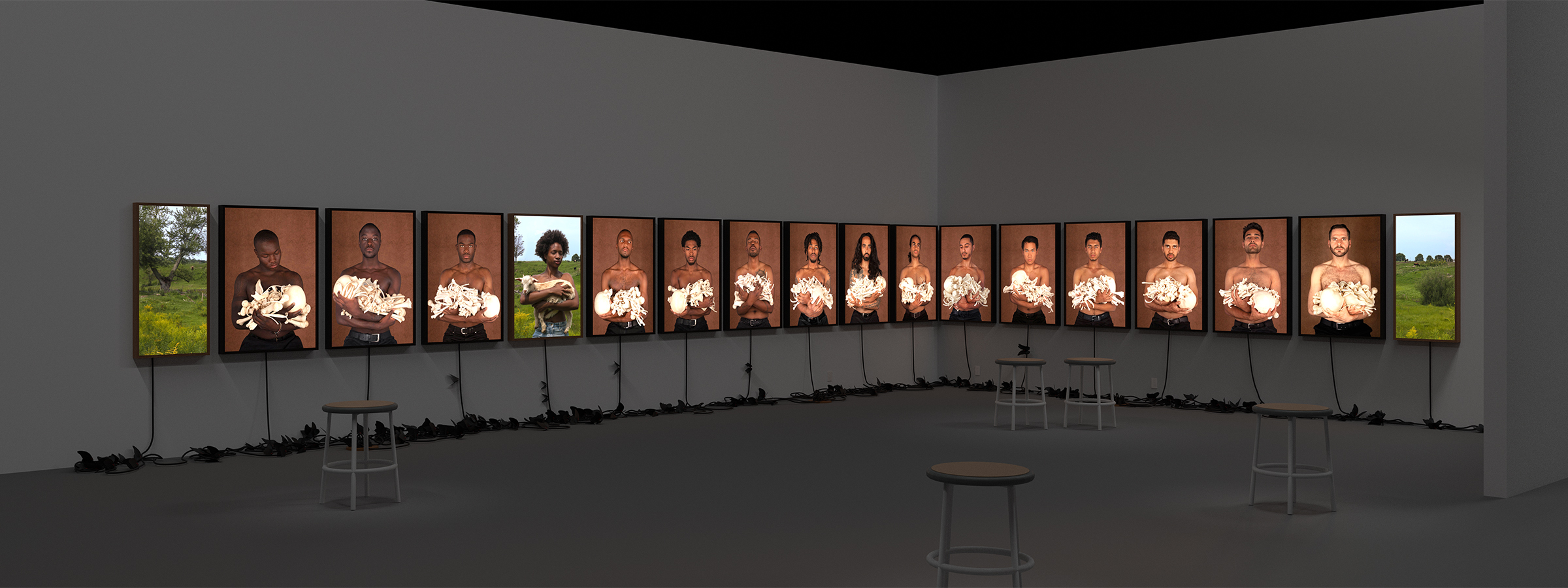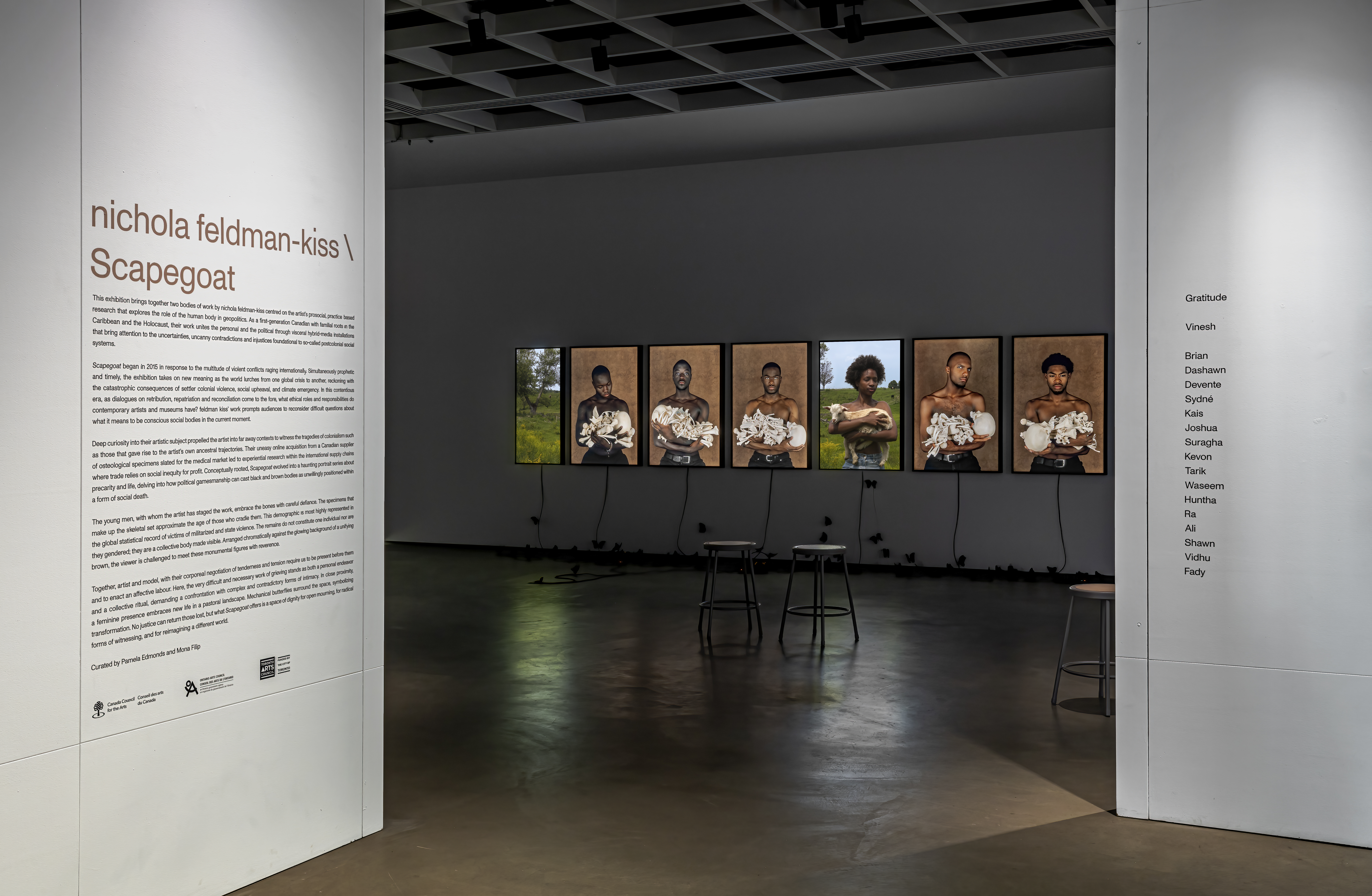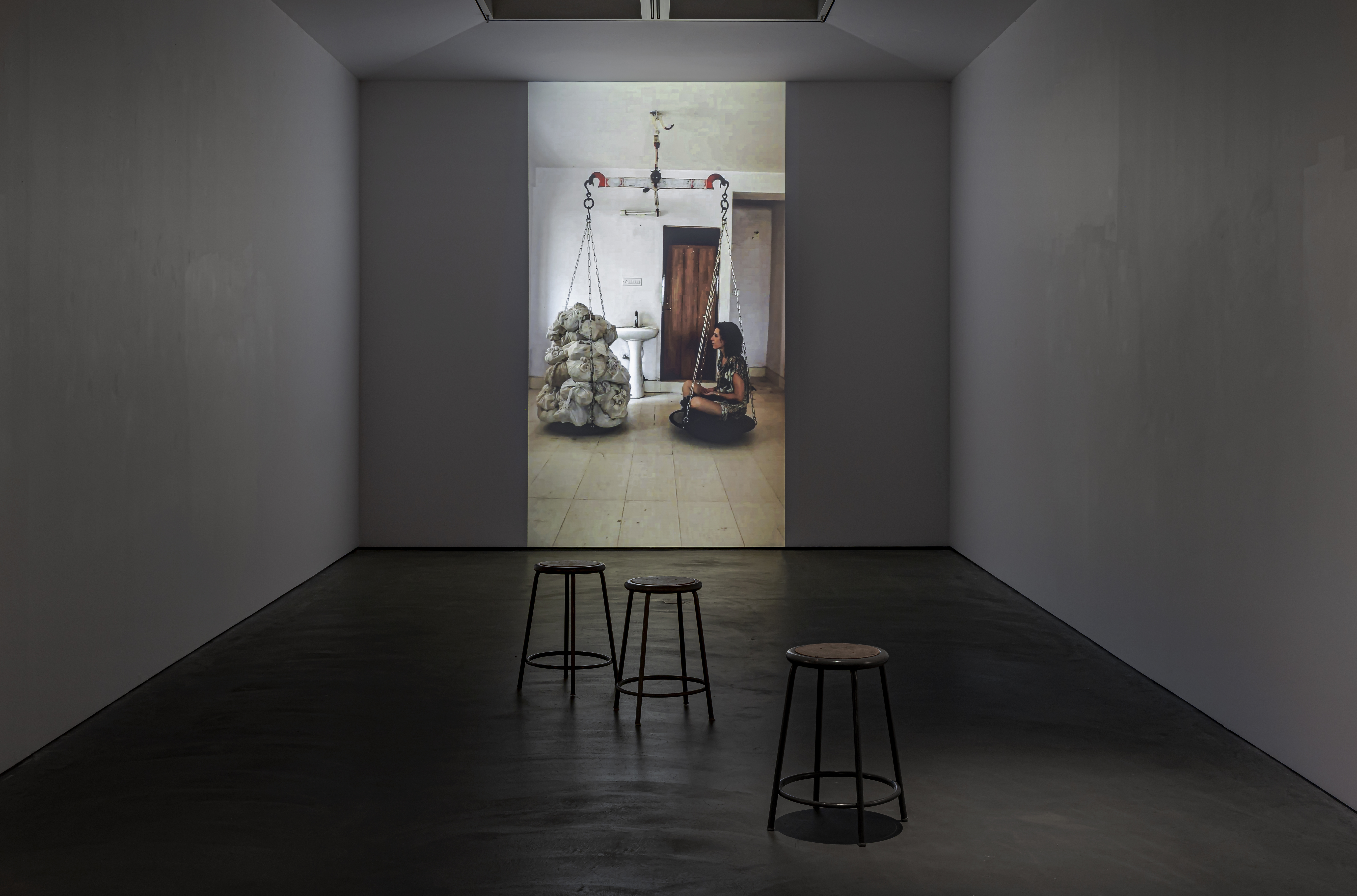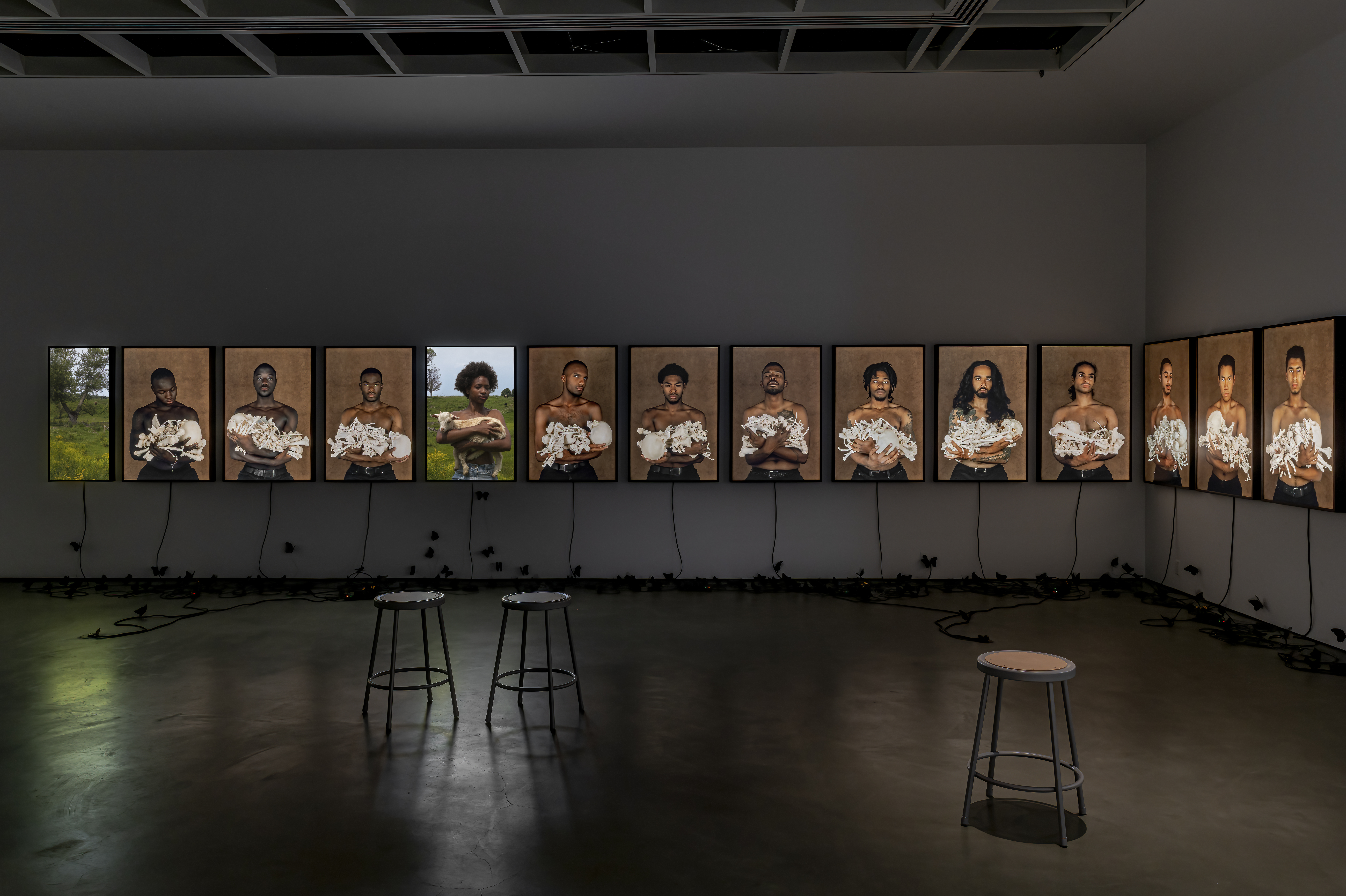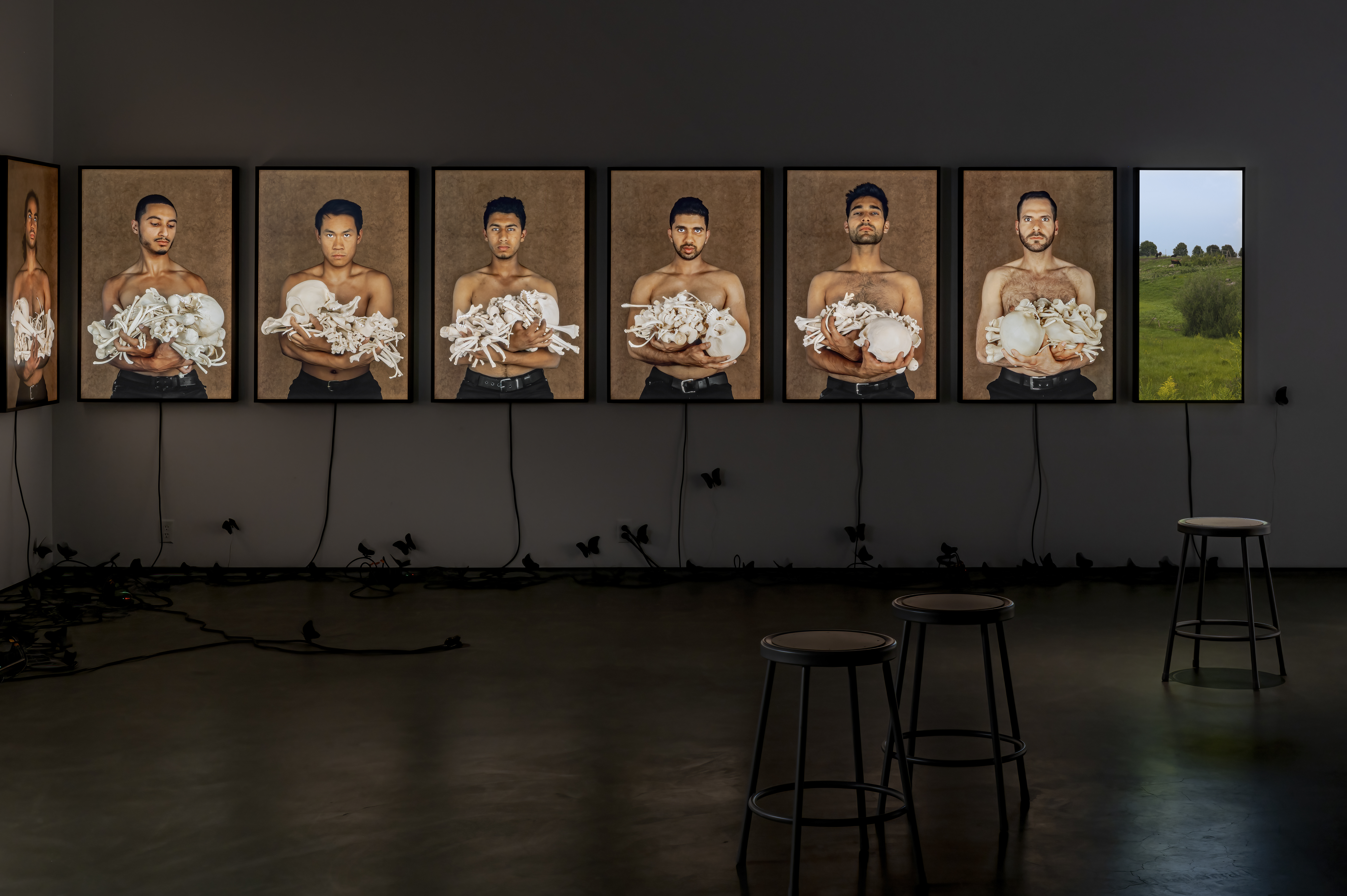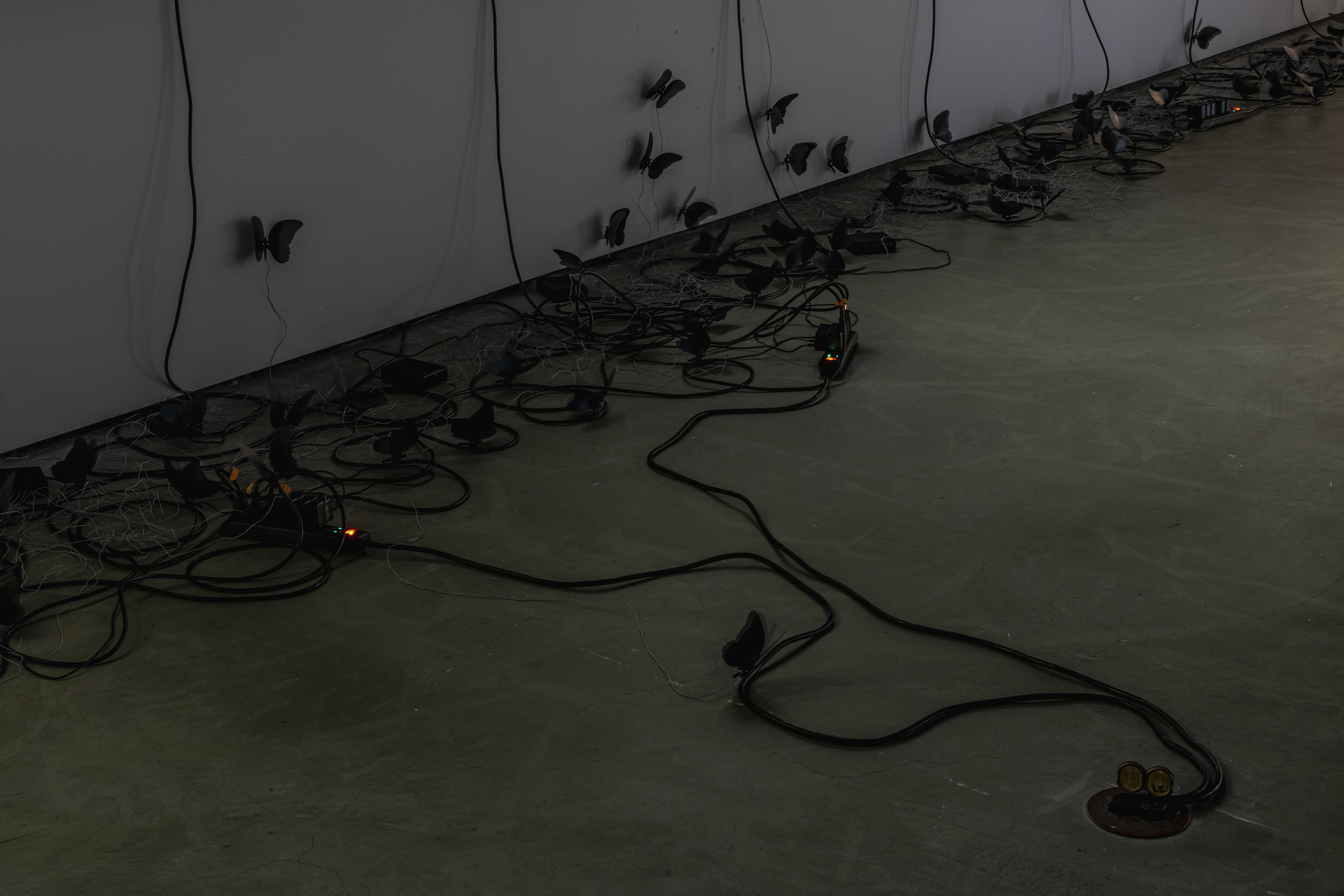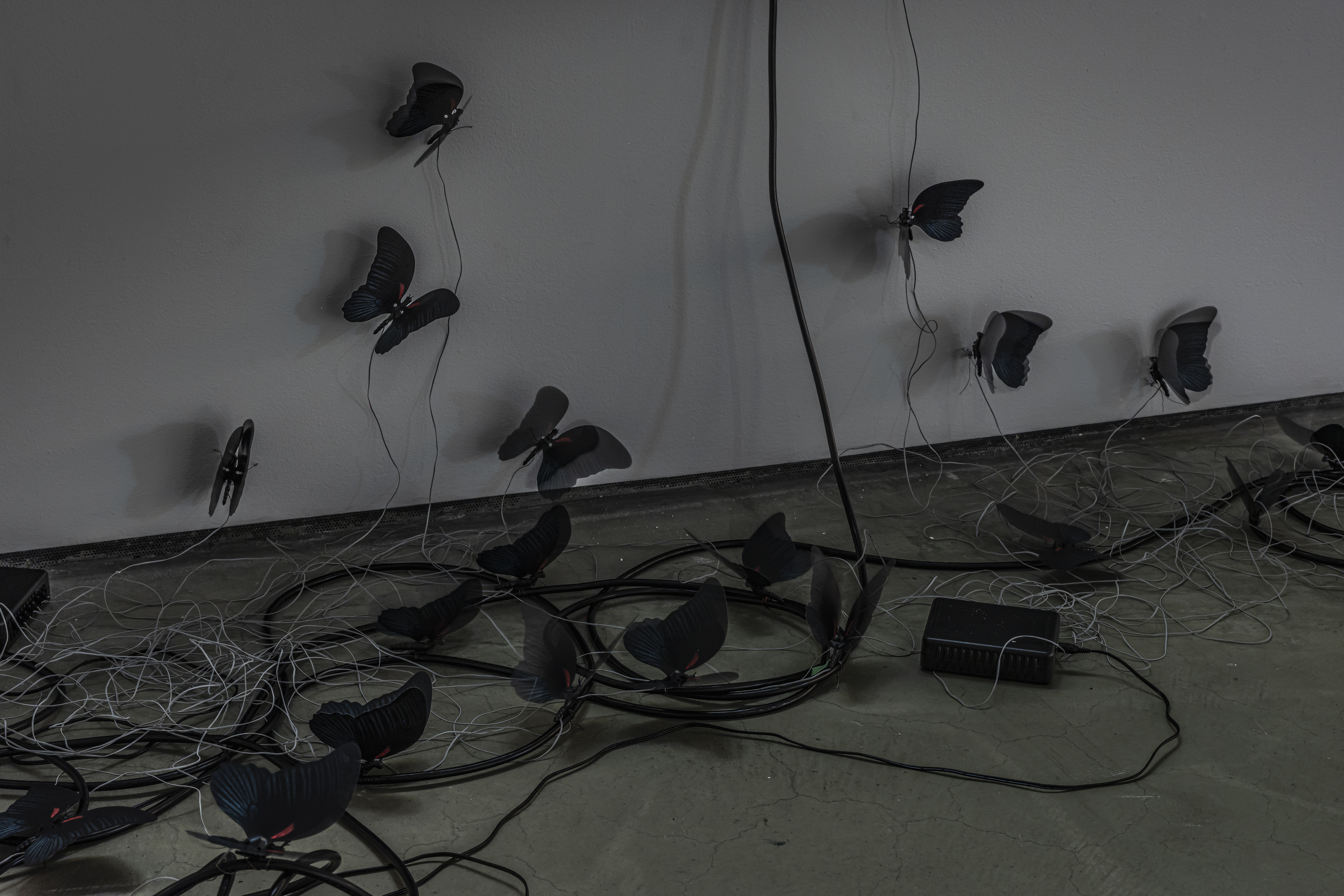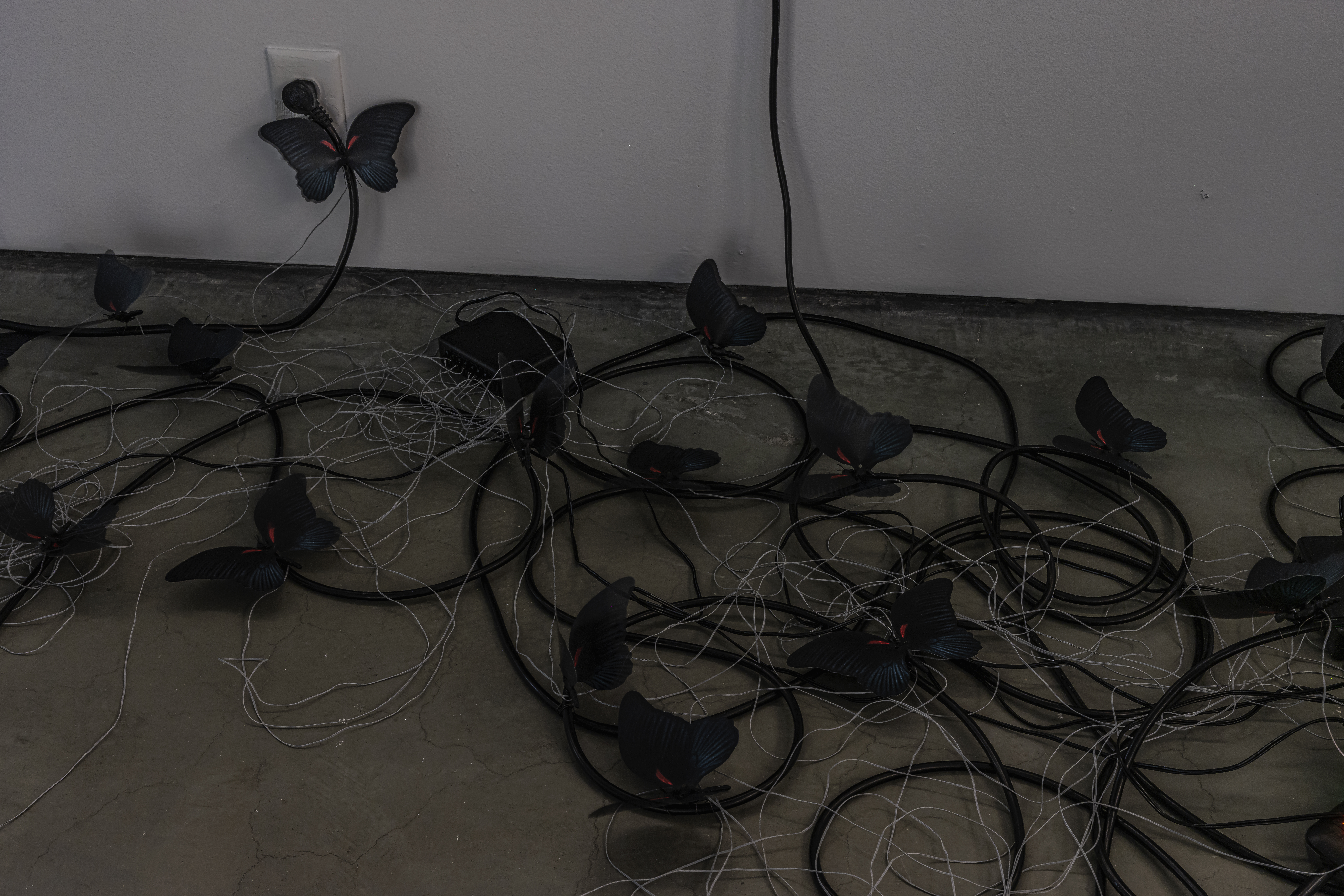an initial aversion to the plight of the sufferer. (Pietà) 2015 — 2022 \ Scapegoat / McMaster Museum of Art
3D Render Gratitude to Adrienne
Gratitude to Brian, Dashawn, Devente, Joshua, Sydné, Kais, Suragha, Kevon, Tarik, Waseem, Huntha, Ra, Ali, Shawn, Vidhu and Fady
feldman-kiss’ Toronto studio was the site for staging this conceptual portrait series which continues their critical explorations of colonial power and its devastating effects. Exhibited for the first time in its entirety, this collection of illuminated tableau photographs refashions the iconography of the Pietà, a popular biblical subject in classical European art which depicts Mary holding and mourning the body of Christ after his sacrificial death. A range of young male subjects each cradle a set of pristine white bones, referencing Pietà's devotional themes of martyrdom and mourning. Arranged chromatically by skin tone against a backdrop of unifying brown, these men represent the demographic most directly impacted by systemic violence and discrimination.
Dignified and defiant, individually named and collective, the young men are survivors of alienation, dislocation, racism, police brutality and surveillance in their urban Toronto communities. While some refute our gaze and others meet it, each figure is positioned in unison with equal reverence. The anonymity of the skeletal set is at the forefront of the artist’s critique. Though fully legitimized in Canada through institutionalized frameworks, its status as product raises ethical issues about complicity and moral consent, a tragic reminder of young lives needlessly lost within racial capitalism. Marking erasure and absence, the opposite corner of the gallery is left bare, a zone that resists simple articulation, its empty walls offering open space for re-imaginings. feldman-kiss proposes to make collective space to commune through public grief as a form of activism, and sanctuary for recuperative care and radical dependency.
feldman-kiss’ more recent work, Scapegoat (Syndé), presents a youthful feminine subject seen holding a baby goat in a pastoral landscape. Bracketing the images and placing them within the (Pietà) works, feldman-kiss unsettles the traditional narrative of the triptych’s form. Composed of three-dimensional objects, the installation also takes on a sculptural presence, impacting our physical sense of orientation. These haunting works reflect the artist’s understanding of the power that photography has on shaping public awareness of social conditions. While the kid goat stands as an ambiguous symbol of the sacred and the sacrificed, the model’s closed eyes and awkward pose destabilizes our gaze, suggesting a protest against the historical exploitation of the Black female figure within Western culture. Here, her African body can also be considered as the mother of civilization and a prime life force connecting all of human-kind.
Pamela Edmonds, Curator
an initial aversion to the plight of the sufferer. (Pietà) 2015 — 2022 \ Scapegoat / McMaster Museum of Art
backlight photo installation — 16 (33.5” wide x 49.5” tall x 3” deep framed) and 2 (21” wide x 48” tall x 3” deep framed)
Gratitude to Brian, Dashawn, Devente, Joshua, Sydné, Kais, Suragha, Kevon, Tarik, Waseem, Huntha, Ra, Ali, Shawn, Vidhu and Fady
feldman-kiss’ Toronto studio was the site for staging this conceptual portrait series which continues their critical explorations of colonial power and its devastating effects. Exhibited for the first time in its entirety, this collection of illuminated tableau photographs refashions the iconography of the Pietà, a popular biblical subject in classical European art which depicts Mary holding and mourning the body of Christ after his sacrificial death. A range of young male subjects each cradle a set of pristine white bones, referencing Pietà's devotional themes of martyrdom and mourning. Arranged chromatically by skin tone against a backdrop of unifying brown, these men represent the demographic most directly impacted by systemic violence and discrimination.
Dignified and defiant, individually named and collective, the young men are survivors of alienation, dislocation, racism, police brutality and surveillance in their urban Toronto communities. While some refute our gaze and others meet it, each figure is positioned in unison with equal reverence. The anonymity of the skeletal set is at the forefront of the artist’s critique. Though fully legitimized in Canada through institutionalized frameworks, its status as product raises ethical issues about complicity and moral consent, a tragic reminder of young lives needlessly lost within racial capitalism. Marking erasure and absence, the opposite corner of the gallery is left bare, a zone that resists simple articulation, its empty walls offering open space for re-imaginings. feldman-kiss proposes to make collective space to commune through public grief as a form of activism, and sanctuary for recuperative care and radical dependency.
feldman-kiss’ more recent work, Scapegoat (Syndé), presents a youthful feminine subject seen holding a baby goat in a pastoral landscape. Bracketing the images and placing them within the (Pietà) works, feldman-kiss unsettles the traditional narrative of the triptych’s form. Composed of three-dimensional objects, the installation also takes on a sculptural presence, impacting our physical sense of orientation. These haunting works reflect the artist’s understanding of the power that photography has on shaping public awareness of social conditions. While the kid goat stands as an ambiguous symbol of the sacred and the sacrificed, the model’s closed eyes and awkward pose destabilizes our gaze, suggesting a protest against the historical exploitation of the Black female figure within Western culture. Here, her African body can also be considered as the mother of civilization and a prime life force connecting all of human-kind.
Pamela Edmonds, Curator
between here and there \ Human toll \ 2012 and 2016
Isolated sound projection — sound installation speech synthesizer, world-wide conflict related death toll database recited in reverse chronology 2014-1989, 198:00 minutes Gratitude to Uppsala Conflict Data Program
and
The King’s two Bodies \ Scales of Justice \ 2016
performance mediation — video projection, 10:11 minutes Gratitude to Vinesh
between here and there \ Human toll \ 2012 and 2016
A pioneer in early digital art, feldman-kiss’ multisensory installations continue to explore the human body - including their own - as a site of confrontation, vulnerability and resistance. between here and there began as a labour of research that the artist undertook following their 2011 return from Sudan, where they were embedded as a UN military observer in the generations-old east-African conflict as a part of the Canadian Forces Artists Program. In travelling to this site of active warfare, the artist sought to shock herself out of complacency through dislocation from first-world privilege, however temporary. Born and raised in Ottawa, feldman-kiss aspired to a deeper, more visceral empathic connection with the experiences of their familial ancestors, with diasporic Afro-Euro-Sephardi-Jamaican heritage (connected to conquest, colonization and the trans-Atlantic slave trade) on their maternal side, and Lutheran-German-Ashkenazi-Polish heritage (in flight from anti-Semitic and anti-miscegenation policies) on their paternal side. The artist’s pivotal experience embedded in an African conflict zone awakened a preoccupation with world order and relative human value, provoking further durational work about how to make sense of one’s implication in colonial history.
Audio read-out by a monotone computerized voice sets the tone for this disquieting installation which represents a twenty-five-year statistical database of death-toll records in conflict ridden regions across the world (https://ucdp.uu.se/downloads/index.html#battlerelated). Evolving from their efforts to understand the cacophonous narratives issued by the global news industry, feldman-kiss employs the uncanny quality of a sound projection device to create a contained listening space, one that demands an attentive form of embodied listening. The relentless drone of human tolls suspends us in an uncanny space between horror and banality. This evocative work can be read as a meditation on public memorialization, drawing our attention to the connection between archive and trauma. It asks audiences to consider questions like: What are the regulatory norms through which different bodies are materialized? How are ethical relations bound by the consumption of global violence? How does anonymity and otherness impact the notion that some lives can be more easily disregarded if they are lived at a distance?
The King’s two Bodies \ Scales of Justice \ 2016
I meditated on finitude, the foibles of imagination, demystification of truth and the scaling of justice in our globalizing world. I captured rich and exotic audio, video and photographic source material as I swept, sorted and sat in balance floating on my pan facing down death. By day 49 day it had become clear I had flown very close to the flame…In my journey’s dissociation, I encountered an inner cold colder than any Canadian winter as my body wept from every pore under the oppressions of 55˚C.
The opening quote is taken from feldman-kiss’ diaristic entries during what the artist describes as a durational performance over months in residence living and working in West Bengal, India in 2016 with a supplier’s vast inventory of human osteological specimens. Once destined to the international market of medical teaching aids, the artist’s immersion into these trade sources enabled their experiential understanding of the precarious cultural and socio-economic circumstances from which commercial specimens in the Canadian inventory may have been harvested (or originated). feldman-kiss’ gesture troubles the conflicting legal frameworks that govern these little-known global markets established with colonization.
The projected video of The King's Two Bodies \ Scales of Justice shows the artist balancing their body on a commercial pan and chain beam scale staged within an ambiguous pseudo-domestic setting. For the majority of the performance before the camera, they sit in a meditative posture in the face of their weight in shrouded human bone bundles. In this confrontation with taboo, feldman-kiss’ artistic action positions their own body/psyche within the artwork as a site of political resistance and complicates the aesthetics and interpretations of Western conceptualizations of self-representation.
Pamela Edmonds, Curator
an initial aversion to the plight of the sufferer. (Pietà) 2015 — 2022 \ Scapegoat / McMaster Museum of Art
backlight photo installation — 16 (33.5” wide x 49.5” tall x 3” deep framed) and 2 (21” wide x 48” tall x 3” deep framed)
Gratitude to Brian, Dashawn, Devente, Joshua, Sydné, Kais, Suragha, Kevon, Tarik, Waseem, Huntha, Ra, Ali, Shawn, Vidhu and Fady
feldman-kiss’ Toronto studio was the site for staging this conceptual portrait series which continues their critical explorations of colonial power and its devastating effects. Exhibited for the first time in its entirety, this collection of illuminated tableau photographs refashions the iconography of the Pietà, a popular biblical subject in classical European art which depicts Mary holding and mourning the body of Christ after his sacrificial death. A range of young male subjects each cradle a set of pristine white bones, referencing Pietà's devotional themes of martyrdom and mourning. Arranged chromatically by skin tone against a backdrop of unifying brown, these men represent the demographic most directly impacted by systemic violence and discrimination.
Dignified and defiant, individually named and collective, the young men are survivors of alienation, dislocation, racism, police brutality and surveillance in their urban Toronto communities. While some refute our gaze and others meet it, each figure is positioned in unison with equal reverence. The anonymity of the skeletal set is at the forefront of the artist’s critique. Though fully legitimized in Canada through institutionalized frameworks, its status as product raises ethical issues about complicity and moral consent, a tragic reminder of young lives needlessly lost within racial capitalism. Marking erasure and absence, the opposite corner of the gallery is left bare, a zone that resists simple articulation, its empty walls offering open space for re-imaginings. feldman-kiss proposes to make collective space to commune through public grief as a form of activism, and sanctuary for recuperative care and radical dependency.
feldman-kiss’ more recent work, Scapegoat (Syndé), presents a youthful feminine subject seen holding a baby goat in a pastoral landscape. Bracketing the images and placing them within the (Pietà) works, feldman-kiss unsettles the traditional narrative of the triptych’s form. Composed of three-dimensional objects, the installation also takes on a sculptural presence, impacting our physical sense of orientation. These haunting works reflect the artist’s understanding of the power that photography has on shaping public awareness of social conditions. While the kid goat stands as an ambiguous symbol of the sacred and the sacrificed, the model’s closed eyes and awkward pose destabilizes our gaze, suggesting a protest against the historical exploitation of the Black female figure within Western culture. Here, her African body can also be considered as the mother of civilization and a prime life force connecting all of human-kind.
Pamela Edmonds, Curator
an initial aversion to the plight of the sufferer. (Pietà) 2015 — 2022 \ Scapegoat / McMaster Museum of Art
backlight photo installation — 16 (33.5” wide x 49.5” tall x 3” deep framed) and 2 (21” wide x 48” tall x 3” deep framed)
Gratitude to Brian, Dashawn, Devente, Joshua, Sydné, Kais, Suragha, Kevon, Tarik, Waseem, Huntha, Ra, Ali, Shawn, Vidhu and Fady
feldman-kiss’ Toronto studio was the site for staging this conceptual portrait series which continues their critical explorations of colonial power and its devastating effects. Exhibited for the first time in its entirety, this collection of illuminated tableau photographs refashions the iconography of the Pietà, a popular biblical subject in classical European art which depicts Mary holding and mourning the body of Christ after his sacrificial death. A range of young male subjects each cradle a set of pristine white bones, referencing Pietà's devotional themes of martyrdom and mourning. Arranged chromatically by skin tone against a backdrop of unifying brown, these men represent the demographic most directly impacted by systemic violence and discrimination.
Dignified and defiant, individually named and collective, the young men are survivors of alienation, dislocation, racism, police brutality and surveillance in their urban Toronto communities. While some refute our gaze and others meet it, each figure is positioned in unison with equal reverence. The anonymity of the skeletal set is at the forefront of the artist’s critique. Though fully legitimized in Canada through institutionalized frameworks, its status as product raises ethical issues about complicity and moral consent, a tragic reminder of young lives needlessly lost within racial capitalism. Marking erasure and absence, the opposite corner of the gallery is left bare, a zone that resists simple articulation, its empty walls offering open space for re-imaginings. feldman-kiss proposes to make collective space to commune through public grief as a form of activism, and sanctuary for recuperative care and radical dependency.
feldman-kiss’ more recent work, Scapegoat (Syndé), presents a youthful feminine subject seen holding a baby goat in a pastoral landscape. Bracketing the images and placing them within the (Pietà) works, feldman-kiss unsettles the traditional narrative of the triptych’s form. Composed of three-dimensional objects, the installation also takes on a sculptural presence, impacting our physical sense of orientation. These haunting works reflect the artist’s understanding of the power that photography has on shaping public awareness of social conditions. While the kid goat stands as an ambiguous symbol of the sacred and the sacrificed, the model’s closed eyes and awkward pose destabilizes our gaze, suggesting a protest against the historical exploitation of the Black female figure within Western culture. Here, her African body can also be considered as the mother of civilization and a prime life force connecting all of human-kind.
Pamela Edmonds, Curator
an initial aversion to the plight of the sufferer. (Pietà) 2015 — 2022 \ Scapegoat / McMaster Museum of Art
backlight photo installation — 16 (33.5” wide x 49.5” tall x 3” deep framed) and 2 (21” wide x 48” tall x 3” deep framed)
Gratitude to Brian, Dashawn, Devente, Joshua, Sydné, Kais, Suragha, Kevon, Tarik, Waseem, Huntha, Ra, Ali, Shawn, Vidhu and Fady
feldman-kiss’ Toronto studio was the site for staging this conceptual portrait series which continues their critical explorations of colonial power and its devastating effects. Exhibited for the first time in its entirety, this collection of illuminated tableau photographs refashions the iconography of the Pietà, a popular biblical subject in classical European art which depicts Mary holding and mourning the body of Christ after his sacrificial death. A range of young male subjects each cradle a set of pristine white bones, referencing Pietà's devotional themes of martyrdom and mourning. Arranged chromatically by skin tone against a backdrop of unifying brown, these men represent the demographic most directly impacted by systemic violence and discrimination.
Dignified and defiant, individually named and collective, the young men are survivors of alienation, dislocation, racism, police brutality and surveillance in their urban Toronto communities. While some refute our gaze and others meet it, each figure is positioned in unison with equal reverence. The anonymity of the skeletal set is at the forefront of the artist’s critique. Though fully legitimized in Canada through institutionalized frameworks, its status as product raises ethical issues about complicity and moral consent, a tragic reminder of young lives needlessly lost within racial capitalism. Marking erasure and absence, the opposite corner of the gallery is left bare, a zone that resists simple articulation, its empty walls offering open space for re-imaginings. feldman-kiss proposes to make collective space to commune through public grief as a form of activism, and sanctuary for recuperative care and radical dependency.
feldman-kiss’ more recent work, Scapegoat (Syndé), presents a youthful feminine subject seen holding a baby goat in a pastoral landscape. Bracketing the images and placing them within the (Pietà) works, feldman-kiss unsettles the traditional narrative of the triptych’s form. Composed of three-dimensional objects, the installation also takes on a sculptural presence, impacting our physical sense of orientation. These haunting works reflect the artist’s understanding of the power that photography has on shaping public awareness of social conditions. While the kid goat stands as an ambiguous symbol of the sacred and the sacrificed, the model’s closed eyes and awkward pose destabilizes our gaze, suggesting a protest against the historical exploitation of the Black female figure within Western culture. Here, her African body can also be considered as the mother of civilization and a prime life force connecting all of human-kind.
Pamela Edmonds, Curator
between here and there \ 2015
kinetic installation (simulated butterflies; plastics; cabling, programming; electronics)
This iteration of feldman-kiss’ between here and there series consists of a flock of mechanical butterflies alight on a cluster of electrical wiring components originating from the (Pietà)/Scapegoat) backlit portraits. Beneath the illuminated images, a tangle of black cabling and power supplies are gathered on the gallery floor, the electronically powered butterflies gather, animating the darkened space with their subtle fluttering. The artist does not attempt to conceal or camouflage this power equipment as is customary with media installations, rather they accentuate its messy materiality, resisting the implied neutrality of the modernist white cube gallery. Kinetic art, which relies on motion for effect, introduces elements of time and space to the artwork. It also suggests the merging of nature, humanity and technology, pointing to the profound effects each has on the other in our contemporary world, in this age of the Anthropocene.
Noteworthy, the butterfly stands as a potent metaphor for transformation, hope, and renewed life. In some cultures, it is a symbol of the soul of the deceased. The insect’s bodily movements, migrations and feeding methods also play a crucial role in increasing biodiversity on the planet. The manufactured ones shown here are a hybrid of a swallowtail and monarch, the latter facing endangerment and extinction due to climate change and deforestation caused by industry. feldman-kiss’ art asserts a decidedly posthumanist perspective, one which calls for a form of ethical accountability for all life, based on a strong sense of collectivity, relationality and community building.
Pamela Edmonds, Curator
between here and there \ 2015
kinetic installation (simulated butterflies; plastics; cabling, programming; electronics)
This iteration of feldman-kiss’ between here and there series consists of a flock of mechanical butterflies alight on a cluster of electrical wiring components originating from the (Pietà)/Scapegoat) backlit portraits. Beneath the illuminated images, a tangle of black cabling and power supplies are gathered on the gallery floor, the electronically powered butterflies gather, animating the darkened space with their subtle fluttering. The artist does not attempt to conceal or camouflage this power equipment as is customary with media installations, rather they accentuate its messy materiality, resisting the implied neutrality of the modernist white cube gallery. Kinetic art, which relies on motion for effect, introduces elements of time and space to the artwork. It also suggests the merging of nature, humanity and technology, pointing to the profound effects each has on the other in our contemporary world, in this age of the Anthropocene.
Noteworthy, the butterfly stands as a potent metaphor for transformation, hope, and renewed life. In some cultures, it is a symbol of the soul of the deceased. The insect’s bodily movements, migrations and feeding methods also play a crucial role in increasing biodiversity on the planet. The manufactured ones shown here are a hybrid of a swallowtail and monarch, the latter facing endangerment and extinction due to climate change and deforestation caused by industry. feldman-kiss’ art asserts a decidedly posthumanist perspective, one which calls for a form of ethical accountability for all life, based on a strong sense of collectivity, relationality and community building.
Pamela Edmonds, Curator
between here and there \ 2015
kinetic installation (simulated butterflies; plastics; cabling, programming; electronics)
This iteration of feldman-kiss’ between here and there series consists of a flock of mechanical butterflies alight on a cluster of electrical wiring components originating from the (Pietà)/Scapegoat) backlit portraits. Beneath the illuminated images, a tangle of black cabling and power supplies are gathered on the gallery floor, the electronically powered butterflies gather, animating the darkened space with their subtle fluttering. The artist does not attempt to conceal or camouflage this power equipment as is customary with media installations, rather they accentuate its messy materiality, resisting the implied neutrality of the modernist white cube gallery. Kinetic art, which relies on motion for effect, introduces elements of time and space to the artwork. It also suggests the merging of nature, humanity and technology, pointing to the profound effects each has on the other in our contemporary world, in this age of the Anthropocene.
Noteworthy, the butterfly stands as a potent metaphor for transformation, hope, and renewed life. In some cultures, it is a symbol of the soul of the deceased. The insect’s bodily movements, migrations and feeding methods also play a crucial role in increasing biodiversity on the planet. The manufactured ones shown here are a hybrid of a swallowtail and monarch, the latter facing endangerment and extinction due to climate change and deforestation caused by industry. feldman-kiss’ art asserts a decidedly posthumanist perspective, one which calls for a form of ethical accountability for all life, based on a strong sense of collectivity, relationality and community building.
Pamela Edmonds, Curator
